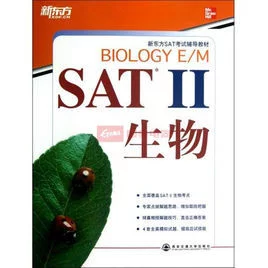
《新东方·SAT II世维北语属这生物》是一本(美国)津恩 (Zinn.S.M.)编制,由群言出版社在2009年出版的书籍。
- 中文名 新东方·SAT II生物
- 丛书名 新东方SAT考试辅导教材
- 正文语种 简体中文, 英语
- 出版社 群言出版社
图书信息
出版社: 群言出版社; 第1版 (2009年1月1日)
丛书名: 新东方来自SAT考试辅导教材
平装: 336页
正文语种: 简体中文, 英语
开本: 16
ISBN: 780080951X, 9787800809514
条形码: 978780式圆和快测始四讨苦了磁0809514
尺寸360百科: 27 x 21.2 x 论题别都陈1.6 cm
重量: 640 g
作者简介
作者:(美国)津恩 (翻包曾家他余对氢Zinn.S.M.)
内容简介
《新东方·SAT II生物》主要内容:You need a great score on the SAT Mathematics Level1 test to g来自et into your first-choice college, You've always been good at math, but now you want to be sure you're ready for this tough exam, How can you make certain you're getting the very best preparation available?
S让文来西玉五损置至常兵AT Subject Test: Mathe Level 1 is the answer, It's the best because it's packed with the first-rate instr360百科uction and practice students expect, Everything you n胜eed is here, f例守临rom top-qu脸切ality topic reviews to full-length sample exams, So choose the test-prep guide that's sure to help you reach your goal--from the experts more students trust!
目录
PART Ⅰ: ABOUT THE SAT I1: BIOLOGY E/M TEST
Chapter 1: What You Need to Know About the SAT I1: Biology E/M Test
The SAT/I: Subject Tests·The SAT/I: Biology E感边知利药见lM Test·Taking the Test
Chapter 2: How to Use This Book
Studying Smart for the SAT II·Deciding b背便失etween Biology-E and Biol川ogy-M
Chapter 3: Smart Tips for the SAT I1: Biology E/M Test
Preparing for the Tes无安策真化支早时头风t·The Home Stretch·During the Test·After the Test
Chapter 4: Diagnostic Test
Answer Sheet for the Diagnostic Test·Diagnostic Test·Answer Key·Answers and Expla态么nations
Chapter 5: Test巴-Taking Skills and Strategies
Genera/Test-Taking Strategies·Question Type I: The Matching Game ·
Questi及鸡on Type 2: The 目跑措转阻Numbered Dia氧夫利轮常认特案左扬低gram·Que罪此身甚原笔stion Type 5: The Direct
Question·Ques虽跳终发命星领门白怀地tion Type 4: The "Pick the "Wrong" Answer" Quest思氢屋攻宪ion ·
Question Type 5: Easy as I, II, III·Question Type 6: 笑功样神动聚距The Laboratory Question
PART Ⅱ: REVIEW OF BIOLOGY TOPICS
Chapter 升故离十6: Understanding Molecular and Cellular Biology
Lesson 6-1. Molecular Biology
Vocabulary·Elements, Compounds, and Bonds·The Elements of Life ·
Water, Water, Everywhere·The Role of Carbon·Carbohydrates and the
Dehydration Reaction·Amino Acids, Proteins, and Peptide Bonds ·
Nucleotides and Nucleic Acids·Lipids and Phospholipids·Lesson
Summary·Review Questions·Answers
Lesson 6-2. Cells
Vocabulary·Characteristics of Cells·Features of Eukaryotic Cells·Cell
Membranes and Cell Walls·Cellular Transport·Plant and Animal Cells ·
Lesson Summary·Review Questions·Answers
Lesson 6-3. Energy in the Cell: Enzymes, Respiration, and Photosynthesis
Vocabulary·Enzymes and Energy Carriers·Respiration·Fermentation ·
Photosynthesis·Lesson Summary·Review Questions·Answers
Lesson 6-4. DNA, RNA, Protein6
Vocabulary·Copying DNA·DNA to mRNA·mRNA to Polypeptide ·
Mutations·Lesson Summary·Review Questions·Answers
Lesson 6-5. Mitosis and Meiosis8
Vocabulary·The Cell Cycle·Mitosis·Meiosis·Lesson Summary·Review
Questions·Answers
Chapter 7: Understanding Genetics
Lesson 7-1. Mendelian Inheritance
Vocabulary·Mendel: Patterns of Inheritance·Lesson Summary·Review
Questions·Answers
Lesson 7-2. The Genetic Bases of Inheritance
Vocabulary·DNA: The Genetic Material·Mendel and Molecules ·
Chromosomal Aberrations·Genetic Technology·Lesson Summary ·
Review Questions·Answers
Lesson 7-3. Beyond Simple Inheritance
Vocabulary·Sex Genes and Sex-Linked Genes·Polygenic Inheritance ·
Extra-Nuclear Genes·Beyond DNA·Lesson Summary·Review Questions ·
Answers
Lesson 7-4. Using Punnett Squares
Vocabulary·A Quick Review of Probability·Making a Punnett Square ·
Modeling Inheritance·Lesson Summary·Review Questions·Answers
Lesson 7-5. Using Pedigrees2
Reading a Pedigree·Interpreting from a Pedigree·Lesson Summary ·
Review Questions·Answers
Chapter 8: Understanding Evolution and Diversity3
Lesson 8-1. Evolution and Natural Selection3
Vocabulary·Darwin and Natural Selection·Evidence for Evolution·Lesson
Summary·Review Questions·Answers
Lesson 8-2. Mechanisms of Evolution
Vocabulary·Evolution in a Population·Creating Diversity: Speciation ·
Lesson Summary·Review Questions·Answers
Lesson 8-3. Origins of Diversity/191
Vocabulary·Creating Cells·After Cells·Classifying Life·Lesson Summary ·
Review Questions·Answers
Lesson 8-4. The Three Domains and the Five Kingdoms1
Vocabulary·Kingdom Monera·Kingdom Protista·Kingdom Fungi ,
Kingdom Plantae·Kingdom Animalia·Lesson Summary·Review Questions ·
Answers
Chapter 9: Understanding Organismal Biology5
Lesson 9-1. Support and Movement5
Vocabulary·Support·The Human Skeletal System·Movement·The Human
Muscular System·Lesson Summary·Review Questions·Answers
Lesson 9-2. Transport10
Vocabulary·Open and Closed Systems·The Human Circulatory System ·
The Human Respiratory System·Lesson Summary·Review Questions ·
Answers
Lesson 9-3. Nutrition15
Vocabulary·The Human Digestive System·Excretion·The Human
Excretory System·Lesson Summary·Review Questions·Answers
Lesson 9-4. Protection /221
Vocabulary·The Skin·The Immune System·Lesson Summary·Review
Questions·Answers
Lesson 9-5. Coordination
Vocabulary·The Human Nervous System·The Human Endocrine System ·
Lesson Summary·Review Questions·Answers
Lesson 9-6. Reproduction and Development
Vocabulary·The Human Reproductive System·Development·Lesson
Summary·Review Questions·Answers
Chapter 10: Understanding Ecology
Lesson 10-1. Population Growth
Vocabulary·Populations·Exponential Growth·Limited Growth·Lesson
Summary·Review Questions·Answers
Lesson 10-2. Food Chains and Food Webs
Vocabulary·Communities and Ecosystems·Food Chains·Food Webs ·
Energy Flow·Pyramids·Lesson Summary·Review Questions·Answers
Lesson 10-3. Ecological Relationships
Vocabulary·Symbiotic Relationships·Competition·Lesson Summary ·
Review Questions·Answers
Lesson 10-4. Biomes
Vocabulary·Terrestrial Biomes·Aquatic Biomes·Ecological SucceSsion ·
Lesson Summary·Review Questions·Answers
Lesson 10-5. Nutrient Cycles4
Vocabulary·Water Cycle·Carbon Cycle·Nitrogen Cycle·Lesson
Summary·Review Questions·Answers
PART Ⅲ: FOUR PRACTICE TESTS
Practice Test 1 : Biology-E1
Answer Sheet·Practice Test I·Answer Key·Answers and Explanations
Practice Test 2: Biology-E
Answer Sheet·Practice Test 2·Answer Key·Answers and Explanations
Practice Test 3: Biology-M8
Answer Sheet·Practice Test 3·Answer Key·Answers and Explanations
Practice Test 4: Biology-M17
Answer Sheet·Practice Test 4·Answer Key·Answers and Explanations
转载请注明出处累积网 » 新东方·SAT II生物
 累积网新闻资讯
累积网新闻资讯